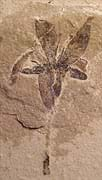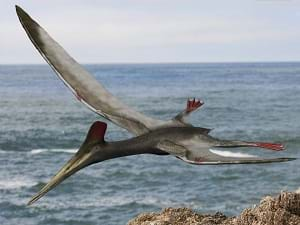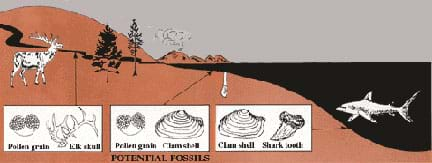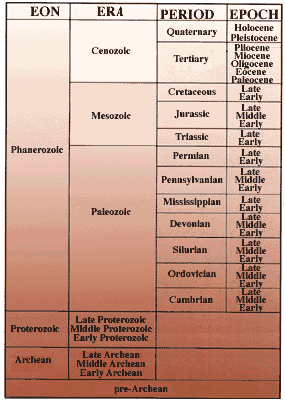Quick Look
Grade Level: 7 (6-8)
Time Required: 15 minutes
Lesson Dependency: None
Subject Areas: Earth and Space

Summary
Students learn about fossils—what they are, how they are formed, and why scientists and engineers care about them.Engineering Connection
Some engineers study fossils to learn about the prehistoric processes and functions that were present in the Earth's history. By understanding how prehistoric creatures lived and became extinct, engineers acquire new ideas for how to design ways to study global climate change and species extinction. Engineers also design the high-tech instrumentation that helps paleontologists discover fossils, especially at the microbial level; these technologies include MRIs, CAT scans and mass spectrometry (or spectroscopy). Engineers are integral to the development of current technologies that use fossils (and fossil fuels) for materials and energy production.
Learning Objectives
After this lesson, students should be able to:
- Define fossil.
- Describe how fossils are formed.
- Explain why engineers might study fossils.
Educational Standards
Each TeachEngineering lesson or activity is correlated to one or more K-12 science,
technology, engineering or math (STEM) educational standards.
All 100,000+ K-12 STEM standards covered in TeachEngineering are collected, maintained and packaged by the Achievement Standards Network (ASN),
a project of D2L (www.achievementstandards.org).
In the ASN, standards are hierarchically structured: first by source; e.g., by state; within source by type; e.g., science or mathematics;
within type by subtype, then by grade, etc.
Each TeachEngineering lesson or activity is correlated to one or more K-12 science, technology, engineering or math (STEM) educational standards.
All 100,000+ K-12 STEM standards covered in TeachEngineering are collected, maintained and packaged by the Achievement Standards Network (ASN), a project of D2L (www.achievementstandards.org).
In the ASN, standards are hierarchically structured: first by source; e.g., by state; within source by type; e.g., science or mathematics; within type by subtype, then by grade, etc.
NGSS: Next Generation Science Standards - Science
-
DCI.ESS2.A.6-8.5.
The planet's systems interact over scales that range from microscopic to global in size, and they operate over fractions of a second to billions of years. These interactions have shaped Earth's history and will determine its future.
(Grades 6 - 8)
More Details
Do you agree with this alignment?
-
DCI.ESS2.B.6-8.3.
Maps of ancient land and water patterns, based on investigations of rocks and fossils, make clear how Earth's plates have moved great distances, collided, and spread apart.
(Grades 6 - 8)
More Details
Do you agree with this alignment?
State Standards
Colorado - Science
-
Describe the geologic time scale and why it is used
(Grade
7)
More Details
Do you agree with this alignment?
-
Geologic time, history, and changing life forms are indicated by fossils and successive sedimentation, folding, faulting, and uplifting of layers of sedimentary rock
(Grade
7)
More Details
Do you agree with this alignment?
Introduction/Motivation
Today we're going to learn about some extremely old stuff—fossils! What are fossils? How are they formed? Why do scientists and engineers care about them? Let's start off with the definition of a fossil: Can anyone explain what a fossil is? A fossil is a remainder of something that lived a long time ago, such as an ancient plant or animal. Most fossils actually come from species that are now extinct.
Fossils help us learn about how the Earth, plants, and animals have changed over time. They also help us better understand the history of the Earth. Paleontologists (scientists who study fossils) can identify a time period for a certain fossil because the oldest fossils are the deepest buried. This makes sense because fossils are formed when soil covers a dead organism, and the hardest parts of the organism leave an imprint in the soil. So, over time, the soil covers more and more organisms, piling on top of the older fossils.

How is engineering related to fossils? Engineers are always trying to get new ideas and be inspired by things. By studying fossils, they can better understand how the prehistoric world worked, and find out details about specific processes. For example, studying pterodactyl bones can help a paleontologist understand exactly how the pterodactyl was able to fly. Engineers can compare and contrast the pterodactyl flying process to other flying methods. They might ask questions such as: Is there anything different and beneficial that the flight process includes? Is the pterodactyl flight process more efficient than other flight processes in any way? Is there anything in the pterodactyl flight process that we should avoid? How successful was the pterodactyl flight process? Engineers ask these types of questions to improve designs for current technologies. When engineers use processes from nature to improve a modern technological process or object, we call it biomimicry.
Engineers design the tools that help discover fossils. Paleontologists once only used hand picks and magnifying glasses to locate fossils. Now they use advanced tools such as magnetic resonance imaging, computer-assisted tomography, and mass spectrometry. Engineers also are involved in the design of technologies that create three-dimensional images of whole organisms from the two- dimensional imprints of fossils. To animate these new 3D images, they study the parts of the organism to discovery how the organism may have moved. Also, the instrumentation used to create chemical models of organisms from fossils is developed by engineers. Chemical analysis of fossils can help us learn more about the environment in which the organism lived, the diseases during that time, and what the organism used for food. Lastly, engineers can also use fossils and fossil fuels to create materials and energy that we use every day.
Lesson Background and Concepts for Teachers
What is a fossil?
A fossil is a remainder of something that lived a very, very long time ago. It can be the image of a plant, animal or even just the trace of an animal, such as its dung or tracks. Refer to the Fossil Fondue activity to have students learn more about how fossils are created by forming their own using small toy figures and melted chocolate.
How are fossils formed?
Animal fossils are formed when an animal dies and slowly becomes covered with soil, mud or silt. Over thousands and thousands of years, the animal decomposes and the hard parts of the body become replaced with minerals; this process is called permineralization.
Fossils are often found in sedimentary rock, which is formed by the layering of material over many years. When plants and animals die, they often sink to the bottom of a river or lake, where they are eventually covered over with soil and/or rock particles. Over time these soil and rock layers slowly become pressed together into hard rock, trapping the plant or animal remains between the layers, as fossils.

Because sedimentary rocks form in layers, scientists believe that fossils also form in layers from the oldest fossil to the youngest fossils. So, the fossils at the bottom of a deep layer of rock are most likely the oldest; the fossils toward the top of a rock are most likely the youngest. Scientists call this the "Law of Superposition."
Just as it makes sense that the fossils at the bottom of a rock would be the oldest, it also makes sense that the sediment that covers up organisms (that later become fossils) would be laid down in horizontal layers. This is called the "law of original horizontality." But, we know that over time, these horizontal layers can shift. Sometimes, sedimentary rock layers are not horizontal, but have been moved or shifted due to some change in the Earth.
How do fossils help us learn about the history of the Earth?
Scientists describe the Earth's long history in time periods that compose a geologic time scale. Time periods are broken up into eons, which are further divided into eras, which are then divided into periods, which are then divided into epochs.

Engineers study fossils from all over the geologic time scale. They look closely at the processes and functions that are found in prehistoric nature and apply them to current technologies. By understanding how prehistoric creatures lived and what caused them to become extinct, engineers can get new ideas for how to design something. Engineers can also use this information to create models of global climate change over the life of the Earth, as well as learn more about species extinction.
Engineering Tools
Engineers design the tools that paleontologists use to discover fossils. Examples include:
- Magnetic resonance imaging (MRI): A noninvasive diagnostic technique that produces computerized images of internal body tissues and is based on nuclear magnetic resonance of atoms within the body induced by the application of radio waves.
- Computer-assisted tomography (CAT scan): A medical imaging method in which digital geometry processing generates a 3D image of the internals of an object from a large series of 2D x-ray images taken around a single axis of rotation; used in many fields for nondestructive materials testing, including detecting cracks in aircraft skins, industrial pipes, underground pipes, corroded reinforcing steel inside concrete, leaking welds, finding broken wires in suspension bridges, and forensics, etc.
- Mass spectrometry (or spectroscopy): An instrumental method for identifying the chemical constitution of a substance by means of the separation of gaseous ions according to their differing mass and charge, for identifying unknown compounds to determine physical, chemical or biological properties of compounds.
Associated Activities
- Fossil Fondue - Students learn more about how fossils are created by forming their own using small toy figures and melted chocolate. With this investigation, they relate how engineers help develop technologies to study the physical and chemical properties of fossilized organisms and increase their knowledge of changing world.
Lesson Closure
Who can tell me: What is a fossil? A fossil is a remainder of an organism that has been preserved in the Earth. What are different types of fossils? Fossils can be from a plant or animal, and they can even be footprints or droppings. Remember that fossils are formed when an organism dies and is covered in soil, fossilizing the hard parts of the remains. Remember that engineers design creative tools to help us find fossils. They also study fossils to get new ideas. They design technologies to help create physical and chemical images of fossilized organisms. This helps us learn about the physical structure of the organism, the environment that it lived in, the diseases that affected it, and what it used for food. Engineers also use fossils and fossil fuels to create materials and energy that we use every day. So, next time you look at a fossil, think about whether there is any way you can apply what you observed to a current technology!
Vocabulary/Definitions
biomimicry: Copying or imitating the special characteristics of naturally existing things (animals, plants, etc.) in human-made designs, products and systems. From bios, meaning life; and mimesis, meaning to imitate.
body fossil: A fossil of an organism's body.
chemical fossil: Also called biomarkers – a chemical trace of an organism.
engineer: A person who applies his/her understanding of science and math to creating things for the benefit of humanity and our world.
extinct: No longer existing.
fossil: A remainder of an organism that has been preserved in the Earth's crust.
geologic time scale : A scientific method for classifying historical time periods.
macrofossil: A larger fossil specimen, one large enough to be observed by direct inspection.
microfossil: A fossil that can be studied only microscopically, and that may be either a fragment of a larger organism or an entire tiny organism.
paleontologist: A person who studies fossils.
paleontology: The study of fossils.
permineralization: The process whereby groundwater permeates an organism and minerals from the groundwater precipitate out and fill the empty spaces in the body, thus forming a body fossil.
trace fossil: A fossil that shows the activity of an animal or plant but is not formed from the organism itself. A trace fossil shows that an organism was present. Examples: burrows, trails, footprints or droppings.
Assessment
Pre-Lesson Assessment
Discussion Question: Ask students the following question and discuss as a class. First see if students can provide a definition before explaining it to them.
- What is a fossil? (Answer: A remainder of something that lived a long time ago, such as a prehistoric plant or animal.)
Post-Introduction Assessment
Class Vote: Ask several true/false questions about the lesson material and have students vote by holding thumbs up for true and thumbs down for false. Tally the votes and write the totals on the board. Give the right answer. Example questions:
- True or False: A piece of animal droppings (poop) can be a fossil. (Answer: True. This type of fossil is called a trace fossil because it shows that an organism was there.)
- True or False: Fossils are formed when people place them into sand for other people to find later. (Answer: False. Fossils are formed by sedimentary rock being formed on top of and around a dead organism.)
- True or False: Paleontology is the study of fossils. (Answer: True)
- True or False: Engineers have no use for studying fossils. (Answer: False. Engineers can get ideas from studying fossils. They can use what they learn about fossils to design new technologies that mimic the prehistoric natural world.)
Lesson Summary Assessment
Creative Writing: Have each student write an essay or letter from the perspective of a plant or animal that becomes fossilized and then is discovered by an engineer. Have them describe in detail how the plant or animal becomes a fossil, and how they are re-discovered after many years. Then have them explain what they helped the engineer to learn and maybe even a new technology that they influenced the engineer in designing. Award extra points for creativity.
Lesson Extension Activities
Arrange a field trip to a natural history museum so students can see examples of fossils.
If you live near a dinosaur dig or other historical dig area, arrange a field trip to a dig site. With advance reservations, some sites allow students to participate in the dig.
Scientists who study fossils are called paleontologists. Have students research what a paleontologist does and give an oral presentation, "A Day in the Life of a Paleontologist."
Ask students to research magnetic resonance imaging, computer-assisted tomography, and mass spectrometry, reporting back to the class a description of what these tools do for us.
Subscribe
Get the inside scoop on all things TeachEngineering such as new site features, curriculum updates, video releases, and more by signing up for our newsletter!More Curriculum Like This

To understand how fossils are formed, students model the process of fossilization by making fossils using small toy figures and melted chocolate. They extend their knowledge to the many ways that engineers aid in the study of fossils, including the development of tools and technologies for determini...

Students are introduced to the concept of energy cycles by learning about the carbon cycle. They learn how carbon atoms travel through the geological (ancient) carbon cycle and the biological/physical carbon cycle.

Students investigate sources of fossil fuels, particularly oil. Through two associated activities, they work with a model of the Earth to learn how engineers and scientists look for oil by taking core samples, and they explore and analyze oil consumption and production in the U.S. and around the wor...
References
Acorn Naturalists: Resources for the Trail and Classroom. Acorn Naturalists, Tustin, CA. www.acornnaturalists.com. Accessed May 17, 2007.
The Busasaurus. Scholastic, Inc. htttp://content.scholastic.com/browse/article.jsp?id=1636, accessed May 17, 2007.
Edwards, Lucy E. and John Pojeta, Jr. Fossils, Rocks and Time: Table of Contents. Last updated August 14, 1997. US Geologic Survey, US Department of the Interior. Accessed May 17, 2007. http://pubs.usgs.gov/gip/fossils/contents.html
Finding Fossils. Dinosaur Dig, San Diego Natural History Museum. Accessed May 17, 2007. http://www.sdnhm.org/archive/kids/dinosaur/index.html
Follow a Vertebrate: Excavation. Denver Museum of Nature & Science. Accessed May 17, 2007. http://www.dmns.org/main/minisites/fossil/vertexc.html
Fossil. Last updated May 17, 2007. Wikipedia, the free encyclopedia. Accessed May 17, 2007. http://en.wikipedia.org/wiki/Fossil
Fossils, Rocks and Time: Fossil Succession. Last updated August 14, 1997. US Geologic Survey, US Department of the Interior. Accessed May 17, 2007. http://pubs.usgs.gov/
Fossils, Rocks and Time: Introduction. Last updated June 26, 1997. US Geologic Survey, US Department of the Interior. Accessed May 17, 2007. http://pubs.usgs.gov/
Geological Engineering. The Princeton Review. www.princetonreview.com. Accessed May 17, 2007.
Krystek, Lee. What is a Fossil? The UnMuseum. www.unmuseum.org. Accessed May 17, 2007.
Merriam-Webster Online. 2007. Merriam-Webster, Incorporated. www.m-w.com. Accessed May 17, 2007. (Source of some vocabulary definitions, with some adaptation)
Paleontology Careers: I Want to Be a Paleontologist! Advice for Students and Parents. Paleontological Research Institution, Ithaca, NY. www.priweb.org. Accessed May 17, 2007.
Shepherd, Roy. What is a fossil? How do fossils form? Where can I find fossils? Fossils: Bringing the Prehistoric World to Life, Adventure Experiences. www.discoveringfossils.co.uk. Accessed May 17, 2007.
Copyright
© 2006 by Regents of the University of ColoradoContributors
Abigail Watrous; Megan Podlogar; Malinda Schaefer Zarske; Denise W. CarlsonSupporting Program
Integrated Teaching and Learning Program, College of Engineering, University of Colorado BoulderAcknowledgements
The contents of this digital library curriculum were developed under grants from the Fund for the Improvement of Postsecondary Education (FIPSE), U.S. Department of Education and National Science Foundation (GK-12 grant no. 0338326). However, these contents do not necessarily represent the policies of the Department of Education or National Science Foundation, and you should not assume endorsement by the federal government.
Last modified: October 9, 2022








User Comments & Tips